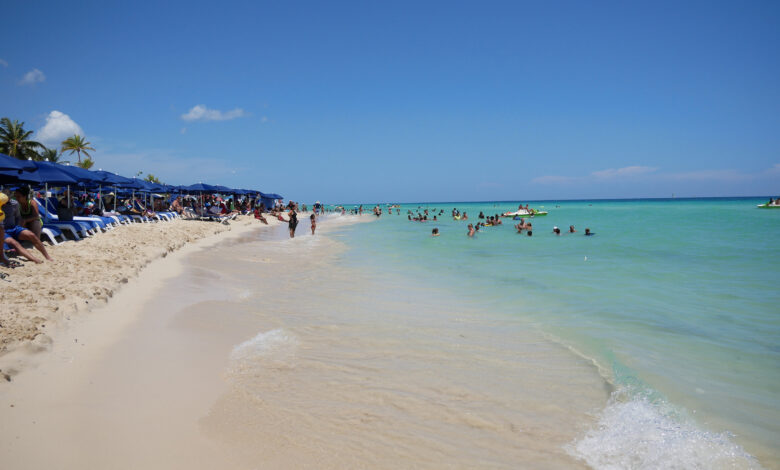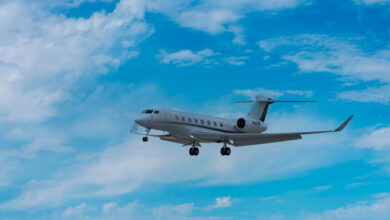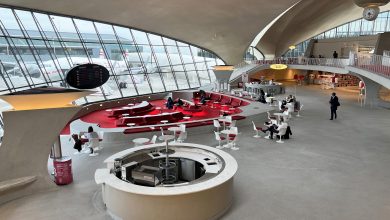
[ad_1]
Cuba is one of those places I’d always wanted to visit but it takes a bit more effort to plan a trip there and I didn’t want to go alone. So when my Australian friend Amanda announced she was visiting the US and wanted to plan a trip to Havana, I was all in.
Before we went I made sure I did plenty of research regarding things to do and places to eat, especially as I wasn’t sure how easy or difficult it would be to gain access to the Internet. We spent a total of three days in Havana and while it was a very jam-packed itinerary, we got to see a lot of the city and even travel further afield.
I’d suggest spending five days or a week in Cuba but if you’re short on time like we were you can still see a lot of things in a long weekend.
Havana is a fascinating place. The first thing you’ll notice when you drive into the city is how the buildings are crumbling and dilapidated. You’ll also notice that the colorful vintage cars you see in photos really are everywhere.
I thought the cars would be just a thing for tourists but that isn’t the case. Since the cars are old, the people who own them are basically mechanics and experts in repairs. Many classic car owners offer their cars and driving services for tours around Havana and the rest of the island.
Besides classic car rides, there are plenty of plazas, museums, cocktail bars and salsa clubs to explore. Here’s my 3 day Havana itinerary:
Day 1: Explore Old Havana, take a vintage car ride and try a mojito
Old Havana is the city centre of Havana and where you’ll spend most of your time exploring. We stayed in the centre of the old town so we could easily access everything on foot. For breakfast I’d recommend visiting El Café, which is an airy breakfast spot serving things like avocado toasts, healthy juices, milkshakes, sandwiches and eggs.
After you’ve had breakfast, it’s time to walk to Hotel Inglaterra, which is where you’ll find all the classic cars lined up. They’re government run and should say “Gran Car” on the side. Some people in Havana do approach you offering tours in their private classic cars but this is not-so-legal and I’d err on the safe side and go with the state-run company.
The cars come in a wide array of colors including reds, pastel pinks and baby blues. Choose the color car you want and make sure to bring cash to pay the driver. Of course, you could book a tour online before you go, but it’s just as easy to rock up and choose one you like.
Tours will usually take you around the city to some of the following spots:
- Nacional Capitol Building
- Chinatown
- Plaza de la Revolución
- Miramar neighborhood
- The seafront avenue, Malecón
- Morro Cabaña Fortress
Our guide, David, was once a journalist but due to the censorship of the media in Cuba (journalists are prevented from being critical of the government), he decided to become a tour guide. He was very knowledgeable and took us to see the major sights on a two hour tour. After hopping in the car we made a stop at a cigar shop, before being driven through Chinatown (Barrio chino), which is the only Chinatown with no Chinese people. Most of them fled the island during the communist revolution in 1959 and didn’t hang around.
Next up we were whisked to Revolution Square, which is one of the largest city squares in the world, measuring 72,000 square metres. The square was the location of many communist rallies and where Fidel Castro would address the nation. The most notable features are the José Martí Memorial statue, and two steel wall-mounted memorials depicting Che Guevara and Camilo Cienfuegos.
Afterwards we stopped for a Daiquiri in the Miramar neighborhood, which was home to affluent Cubans before the revolution, who lived in glamorous mansions and large houses. When the revolution came most of them abandoned their homes and fled to other countries and they were eventually converted into embassies.
Following Miramar we drove along the Malecón, which is an 8km-long promenade that stretches along the coast of Havana. We stopped to take some photos before finishing our tour at Morro Castle (Castillo de los Tres Reyes Magos del Morro), which is a fortress and lighthouse that was constructed to protect the Havana Bay from pirates and colonists. We didn’t do the guided tour but we did walk along the walls and take a second to absorb the views of the ocean.
A classic car tour is definitely a must-do in Havana and it’s a great way to see all the sights of the city without tiring out your legs. Our guide gave us some great insight into the revolution and what life is like for the Cuban people.
After your classic car tour I’d recommend then visiting El Floridita, the legendary bar which was once frequented by Ernest Hemmingway and is now known as “The Cradle of the Daquiri”. It gets rather busy so be prepared for a wait but definitely order a Daiquiri or two in here and listen to the live music.
Once you’ve quenched your thirst, I’d suggest just wandering the streets of Old Havana and sitting outside a restaurant in one of the beautiful plazas. My favorite plaza is Plaza Vieja, where you’ll find an adorable trendy cocktail bar called Azucar Bar & Lounge, which has a terrace offering views over the square. It also happens to have WiFi, which isn’t so easy to come by in Havana!
There are lots of restaurants to choose from in Old Havana. We ate at El Chanchullero, which looks like a hole in the wall place with just a few wooden tables but it’s actually on the trendier side with writing on the ceiling and a nice rooftop. The food is pretty delicious and fresh too, just be prepared to wait for a table if you go after 8pm. A mojito costs $2.50, which is cheaper than what I’d pay for a water back in New York.
Other restaurants which come highly rated on TripAdvisor and Google include Mas Havana, Habana 61, San Ignacio 214, Jibaro’s and Mekede.
Day 2: Playas del Este, La Guarida, Fabrica de Arte
In the morning, take a taxi to Playas del Este, which is a series of beaches about 11 miles east of Havana. The beach is beautiful with white sand and blue water. When we went it was incredibly busy so I’d advise you to get there as early as possible if you want to snag a sun lounger. I loved that this beach was so full of locals as well as tourists – it was great to see how Cubans enjoy their weekends and family time. If you do go, it’s easiest to pre-schedule a taxi back at a specific time so you don’t have any issues getting back or hailing a taxi.
If you’re feeling hungry, there are lots of food vendors on the road by the beach selling Cuban food such as pork chops with rice. The food is cheap and delicious.
Once you’re back in Havana, it’s time for dinner. You’ll read this everywhere on blogs and in forums: the food in Cuba just isn’t that great. I like Cuban food in the US but the food in Cuba is just pretty lacklustre and that’s largely due to the fact that they’re unable to import a lot of stuff so the quality of the ingredients can be lacking. If there’s one restaurant you should try though, it’s La Guarida. Make sure to book in advance as this place can get very busy.
Housed in a deteriorating old mansion known as La Mansión Camagüey, La Guarida has a magnificent marble staircase which is popular for Instagram photos. In fact, the staircase was featured in a shoot that Rihanna did for Vanity Fair. The food is consistent and decent, with plenty of fish and meat dishes to choose from. After dinner, wash your meal down with a cocktail on the rooftop, where you can admire the views of the city.
Fabrica de Arte was my most memorable experience in Havana! I love techno music and I love art so this is a winning combination for me. Listed as one of the world’s “100 greatest places” by TIME, this art gallery/club was established inside a former cooking oil factory. It’s quite the experience and when I went there were long lines to get in. Once inside you can order a drink and then explore the contemporary art which is spread across a labyrinth of different floors and rooms.
After checking out the art I spent most of the night listening to a DJ playing in a big rave-style room at the back of the club. My friend wasn’t into techno too much so she listened to hip hop in the room next door. There are numerous different stages and different styles of music playing, so there’s something for everyone. I’ve been to many bars and clubs over the course of my travels but this is something quite special.
You get given a drink card at the beginning of the night and then you pay for what you drank at the end. I would advise leaving before it ends though as there’s a mad rush to get out once the night is over. The venue is open from Thursday through Sunday, so make sure to time your visit to Cuba with one of these days so you can experience this unique and incredible spot.
Day 3: Day trip to Viñales

For our third day in Havana we booked a vintage car ride to Viñales, which is a beautiful village about 2-3 hours drive from Havana. It’s incredibly lush and green with beautiful scenery and several tobacco plantations.
Our guide David (who drove gave us a tour around Havana on our first day) insisted we see Viñales and since we knew how happy it would make him to take us out there, we agreed to a day trip.
He and his driver showed up with a different car this time – a beautiful red and white one. In hindsight the vintage car wasn’t so comfortable to ride in over long distances and it definitely would have been better to ride in a more modern vehicle but it definitely made for some great photos.
Viñales is absolutely stunning. We visited a cave called Cueva del Indio, which is located near the town of San Vincente. We explored part of the illuminated cave on a motorboat and got to see plenty of stalactites and stalagmites, as well as cave paintings.
Afterwards we went to a tobacco farm where we rode horses and learnt about the art of rolling the perfect Cuban cigar. I didn’t smoke one but you have the opportunity to try it if you want. (If you’re going to buy Cuban cigars, better to buy them out here than in the city.) The horse ride was relaxing and allowed us to soak in the beautiful green scenery of Viñales.
It was a long day but definitely worth it – one of my favorite things to do in Cuba!
Tips for visiting Havana

What is the currency in Cuba?
When I visited Cuba there were two currencies – the CUP (Cuban Peso) and the CUC (Cuban Convertible Peso), which was pegged to the dollar. That all changed though on January 1st 2021, when they switched to only one currency, the CUP (aka the Cuban Peso).
The CUP comes in bills of 1, 3, 5, 10, 20, 50, 100, 200, 500, and 1000.
Bring cash
You cannot use US issued credit cards or debit cards in Cuba.
If you’re from the UK or Europe though you can use your card at the ATMs, hotels etc. Luckily since I’m British I had a British credit card which I used to withdraw money from the ATM in the city no problem.
Still, no matter where you’re from it’s essential really to bring cash to Cuba. If you’re British, bring Pound Sterling, if you’re European, you can bring Euros.
The airports are no longer exchanging dollars for CUP because the government is pushing the de-dollarization of the economy. Therefore, you’ll need to exchange your US dollars for Pounds or Euros BEFORE flying to Cuba.
When you arrive at the airport you can change your Euros or Pounds to CUP at the money change facilities inside the airport. You can also change your money in the city at hotels, resorts, banks and shopping centers. Other currencies you could exchange include:
- Canadian Dollar (CAD)
- Swiss Franc (CHF)
- Japanese Yen (JPY)
- Mexican Peso (MXN)
Before leaving Cuba you’ll want to make sure you can exchange your CUP back again if you have any left over. You can only export a maximum of 2,000 CUP and it would be very difficult to do it when you get back home. There can sometimes be long lines to change your money at the airport so it might be wise to do it in Havana at a hotel or resort.
Is Havana safe?
On my first day in Cuba my friend’s flight was delayed due to a storm so I was alone in Havana for a day. There was a lot of cat-calling from men in the street, which made me feel a bit uncomfortable. When I was walking to the main square I was also followed by a guy who was offering to be my photographer for the day. I politely declined but Cuban people are poor and I guess they’re going to try to find all kinds of ways to make money.
In the daytime I felt fine but I made sure not to walk around too much at night on my own. In the evening I went to a bar close to my hotel as I was in a new place and I knew I wouldn’t be able to access the Internet on my phone.
When my friend arrived I felt safer knowing there were two of us but we were always vigilant with our belongings. As with any country, don’t walk around with valuables on display or wearing expensive jewelry.
Download maps offline
Before going to Havana I favorited all the places I wanted to go on Google Maps. I also made sure I downloaded maps so they were available offline as you can’t get data roaming on your phone in Cuba. You can only access the Internet on WiFi.
Can you get WiFi in Cuba?
There is Internet in Cuba but it’s not readily available like it is in other parts of the world. People don’t have Internet in their homes and you can’t walk to the street and use your phone’s data.
In Havana you’ll often see people crowded around parks and plazas because there are public hotspots in the street where you can access WiFi. You can also find hotspots in hotels and airports.
You will need a NAUTA card to access the Internet, which you can buy with cash from little snack stands. Officially you’re supposed to buy them from ETESCA offices (you must bring a passport) or hotels, but there are people selling them in the street.
The black market street sellers charge a bit more but make sure not to get ripped off: a 5-hour card typically costs 125 CUP, and a 1-hour card costs 25 CUP.
The closest Havana WiFi hotspot near my Airbnb was Plaza del Cristo, which is in the middle of Old Havana. It was quite an experience in itself to go there and sit with all the locals so I could hook myself up to Whatsapp and Instagram. Internet isn’t that fast but it wasn’t too bad either.
That being said, there is actually WiFi available in a handful of bars and restaurants. I regularly went to the trendy Azucar Lounge & Bar in Plaza Vieja for the Internet access, cocktails and techno music.
Where to stay in Havana

When it comes to accommodation in Havana, it’s better to stay in “Casas particulares” or “private homes” because you’re helping the Cuban people. Staying in a casa particular is also cheaper than staying in a hotel and allows you to have a more authentic experience as you’ll experience the Cuban way of life.
Casas are legal because the owner registers with the government to get permission to rent out a room.
You can find plenty of accommodation on Airbnb or on other homestay websites. One of the benefits of booking online before you go is that your accommodation is already paid for up front, so you don’t have to worry about converting lots of cash when you get there to pay for your accommodation.
In case you want to book the same one as I did, I stayed at this Airbnb rental in Havana’s old town.
Conclusion
Cuba is definitely a place everyone should put on their bucket list and the sooner the better, before it changes. A visit to Cuba is like going back in time, almost like a living museum.
Three days in Cuba allowed us to have a small taste of the island but I’d definitely go back and spend longer exploring other parts of the island. Our day trip to Viñales allowed us to see the beauty of the countryside and it’s definitely worth venturing outside the city if you can.
[ad_2]
Source link








